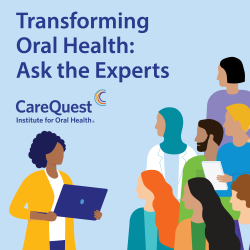Enter your email to receive the CareQuest newsletter:
May 14, 2024

By Renee Clark, Care Coordination & Interoperability Manager at CareQuest Institute
Welcome to the first installment in our blog series about transforming oral health!
Every month, an expert from our Health Transformation team at CareQuest Institute will tackle a question from the oral health community covering one of three topics:
- How care is provided
- How payment is designed and delivered
- How data and reporting are shared and utilized
Making changes within these three areas will help move oral health toward value-based care, a system that ultimately rewards the quality of patient outcomes instead of the quantity of services delivered.
I am hearing more and more about interoperability in oral health. What exactly does interoperability mean?

Over the past few years, technology has changed the way we access and receive health care services. Behind the curtain, there is one key factor that makes it possible to share health care data: interoperability.
When I think about interoperability, I think about “effective communication.” What is effective communication? It is the ability to listen, receive information, understand the information, process the information received, and formulate the proper response when necessary. The more effective the communication, the more both parties involved will have a higher chance of accomplishing the desired outcome they both seek.
Applying this principle to health care, interoperability is the ability for different systems, applications, and devices to connect and share data bidirectionally. In addition, each system should be able to use the data in an effective, seamless, and coordinated manner without the need for user intervention.
The seamless exchange and sharing of data among systems facilitates:
- Improved care coordination
- Fewer errors
- Faster access to care
- Fewer duplicate tests
The ultimate result should be an enhanced patient experience and a more effective outcome.
Interoperability in Action
Let’s look at a scenario to see interoperability in action in an oral health setting: Dental offices regularly take X-rays to check for cavities and monitor our gums. (Sidenote: Guidance around dental X-rays has changed recently, something we covered on a recent CareQuest Institute webinar.) If you develop tooth pain and are referred to see a specialist — especially if that specialist is in a different network — it’s a challenge to share those X-rays. But what if there were a reliable way to share the X-rays with that specialist for review before you arrived for your appointment?
With interoperability, your dentist can do just that, helping facilitate the creation of a proactive treatment plan to provide you with the best care. This can help to expedite diagnostics for the specialist, provide deeper context for the patient referral, and ultimately accelerate information sharing to minimize effort and provide a better patient experience.
Unfortunately, faxing is still the most common method used to share X-rays and dental records with other specialists. Based on the fax machines being used, the received copy of an X-ray may not be legible, which means the imaging shared may be useless and require the specialist to retake X-rays before moving ahead with a treatment plan. But there is good news! As technology and interoperability continue to advance, and the implementation of DICOM standards (Digital Imaging and Communications in Medicine) increases in dental offices, sharing X-rays electronically is expected to become more prevalent.
A Milestone — and the Journey to Better Care Coordination
The 21st Century Cures Act was signed into law on December 13, 2016. In realizing the importance of interoperability, Congress included a provision for the Office of the National Coordinator for Health Information (ONC) to develop and support a secure and trusted exchange framework to enable health information networks to share data at the national level.
To achieve this, the Trusted Exchange Framework and Common Agreement (TEFCA) was established by the ONC and went live with the first set of qualified networks on December 14, 2023. The Common Agreement version 2.0 for TEFCA was recently released on April 22, 2024; it includes requirements to support Health Level Seven (HL7)– and Fast Healthcare Interoperability Resources (FHIR)–based exchanges to further the advancement of interoperability.
TEFCA marks a significant milestone in advancing interoperability in health care by establishing the infrastructure for nationwide connectivity to support secure and seamless data sharing. Furthermore, this will enable data sharing across regional and state line boundaries to better support care coordination.
As technology continues to evolve in oral health and in other specialties, I am confident that interoperability will make a profound impact on health care services, providers, payors, and patients by enabling different systems to communicate effectively and work together seamlessly.
At CareQuest Institute, we will continue to drive interoperability by promoting inclusion of dentistry in data standardization, supporting health information exchange (HIE) initiatives, advancing policy and advocacy efforts, facilitating collaborative partnerships via grantmaking, and promoting innovation and best practices through education.
Editor’s Note: Renee has more than two decades of experience supporting inpatient, emergency department, and outpatient care settings. Throughout her career, Renee has directed various health care IT initiatives including meaningful use, integration, and interoperability with client EHR systems. Notable achievements include leadership on a statewide CMS meaningful use project to assist providers, as well as serving as interoperability consultant for the Office of the National Coordinator for Health Information Technology on their vendor EHR certification program.